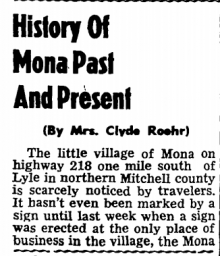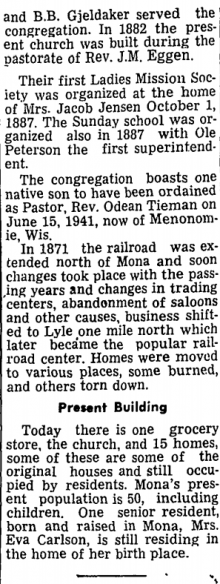History Of Mona Past And Present
History Of
Mona Past
And Present
(By Mrs. Clyde Roehr)
The little village of Mona on highway 218 one mile south of Lyle in northern Mitchell county is scarcely noticed by travelers. It hasn't even been marked by a sign until last week when a sign was erected at the only place of business in the village, the Mona Grocery Store operated by Mrs. Adeline Geffert announcing the year of their Centennial.
Mona isn't the promising town it was in the early 1800's in the days of steam and horses and some of the early townsfolks in that day had destined it to become one of the big cities in north Iowa.
It was first named Hustad for the P. K. Everson family and also the post office which was located in the general store.
The land was first the property of two speculators, George Briggs and C. H. Gregory and no buildings were erected until after the railroad was built by the Cedar Falls and Minnesota Railroad company between 1865 and 1870.
Platted In 1869
The town was platted in 1869 shortly after the railroad reached there, but was not recorded in Mitchell County until May 30, 1870 by G.S. Needham County Recorder, but it was signed on November 1, 1869 by Mary C. Agard and Benjamin E. Agard.
A two story depot was built in 1869 and a frame engine house was built in St. Ansgar & moved to Mona in 1870. Then a roundhouse was erected on the Illnois Central, also a water tower, water softener for the engines and pumping station for the railroad. The town began to grow and Mona became a notable railroad terminal with six passenger trains a day and freights.
Purchase Land
As the railroad was approaching Mona Charles Hughes and J. D. Farley purchased all land platted most of it into blocks and lots. It was originally ten blocks long and 3 1/2 blocks wide with each street named. The main street was named Farley street after J.D. Farley and that main street is still in use as the main gravel road that leads off the highway 218 going directly west past the Mona Grocery. Only one of the original buildings remains on the street today it is the present home of Mr. and Mrs. Norman Anderson. To date one third of the old town south of the main street still remains in lots, everything north of it is either farm land or high way.
Some of the early buildings erected were a general store and post office combined which burned in 1880, it was replaced and more buildings followed.
First Hotel
Mona's first hotel was erected in 1869 by Mrs. Crowell and in 1883 there were two hotels, the second one being run by Mrs. A. A. Merrick and Mrs. E.M. Wheeler. Then came the blacksmith shop started by Mr. Clark. Other business buildings were Frank Penney and J. P. Farley general merchandise store, lumber and coal dealers also run by Penney and Farley.
S. A. Sanford and P.K. Everson and A B. Pike attended the grain trade in the towns elevator. They also had two saloons, one was known as the "Dew Drop Inn" whose proprietor was James Oleson.
A creamery was started April 26, 1883 by Penney Brothers. It was situated on the site northwest of the present grocery store near the tracks on land now owned by Calvin Williams. This creamery was run by a six-horse power steam engine. During the summer months 17 teams and cream haulers covered a distance of 10 square miles gathering cream. During the first six months of operation an average of 9,000 lbs of butterfat was made monthly. This business continued for 10 years. Butterfat at that time sold for 27 cents a pound.
The town also had a doctor, he was Dr. W.F. Cobb who started his practice at Mona following his graduation from the Chicago Medial College in June 1874. He also owned and operated a drugstore in a building north of Farley street which was located where the bend of the highway now swings past Mona. He practiced in his home in the west part of Mona in the home that presently is the home of Mr. and Mrs. Alfred Kittleson. Dr. Cobb's daughter, Mrs. Edna Putman, now 93, now living in St. Paul, recalls her father playing the bass horn in the Mona town band and folks came to Mona for a good time and entertainment.
First Sunday School
Dr. Cobb also organized the first Sunday school in the public school of Mona before the Lutherans organized a congregation. Mrs. Putman also remembers the Lyle folks walking to Mona for church services in the school house.
Other places of business were a hardware store, furniture store, millinery shop, stockyards and dance hall.
One settler told of letting his grain stand in stacks over a year until a threshing machine could be engaged in Mitchell county. After the railroad arrived they no longer had to make the long journey to McGregor.
How Named
Mona received its present name from William C. Caine who came here from the Isle of Mann (in the British Isles). He named it after his sweetheart Ramona Johnson who died after a broken romance and she never got to come to the US. Mr. Caine lived in a small house back in the woods on his farm which is now part of the Thomas Wamstad farm. Caine owned many acres south of Mona and he acquired much livestock. He acquired 160 acres from the government on December 26, 1855 at the age of 26. Part of this farm now is the Pleasant Hill cemetery bought from Caine in 1894. It was his wish that when he died to be buried on his own land and he picked a spot and planted birch trees on the site which at that time was outside of the cemetery plot. Later more ground was needed for the cemetery and today his grave is in the center of the cemetery. He died at the age of 79 and his nephew from England came to settle the estate, and enroute home he lost his life by shipwreck. It wasn't until 1910 that the Caine land was deeded to Mrs. Elizabeth Joughlin (a widow in England) and later sold to McGillvary & Sawyer.
Mona's first cemetery was connected with the town as a public burial ground given to the town by J.P. and Mary Farley November 21, 1879 and was located at the southeast edge of town. There hasn't been a burial there in over 35 years, it was Fred Wheeler whose body was shipped by train from Waterloo and taken from the Mona crossing by horses and wagon to be buried beside his wife and no marker ever marked his burial. The road that led to the cemetery has long been closed and is situated on a small hill in the middle of the Harvey Golberg farm and unkept for years and marked now only by one tree.
The second cemetery was started by the Mona congregation in September 29, 1876 and is located east of Otranto on the black top road. The last burials there were in 1907, they were Eline and Hans Samuelson, both died that same year. It too has been abandoned and unkept for years.
School Houses
Mona has had three schoolhouses, all on the same site. The first one was begun by S. C. Rusted and was built in the spring of 1890 with an 8 months school term. It was enlarged in 1899, and H.C. Ackerman was hired to teach the upper grades for $38 per month, including the janitor work. The lower grade department was let to Jennie Rustad for the spring term of 10 weeks for $20 per month. Found in the old school records of 1890, it stated if a pupil was absent of tardy three times without a reasonable excuse by the parents the pupil had to appear before a committee appointed by the board to be re-instated.
Dr. Cobb, who served as school secretary was paid $2.50 for sawing and splitting a cord of wood for the school kindling and to haul the banking away in the spring from the schoolhouse.
In 1899 a new two-room school house was built and completed in September that year for $1400 and seated 100 pupils. Bids went to local folks, Lund and Hume. S. J. Peshak was paid $25 to move the old schoolhouse next door on the Harvey Golberg farm where it was used as a chicken house for many hears and still stands on the same spot.
The 1908 records show that 155 pupils attended there. In 1909 the school term ran until July 4. This school burned in 1922.
The last school was erected soon after and was modernized in later years. In 1963 the school was closed and pupils taken by bus to Otranto and St. Ansgar. In 1965 the building was sold to Mr. and Mrs. Dale Bensend who remodeled it into a modern residence. (Mrs. Bensend is the former Donna Duenow) who received all of her eight years of elementary education in that schoolhouse.
Mona Lutheran
The Mona Lutheran church is the only church ever to be in Mona and still is in existence. The congregation was organized September 29, 1876 and when they were part of First Lutheran at St. Ansgar and Six Mile Grove at Lyle and during that period the Rev. C. L. Clausen, J. Olson, and B. B. Gjeldaker served the congregation. In 1882 the present church was built during the pastorate of Rev. J.M. Eggen.
Their first Ladies Mission Society was organized at the home of Mrs. Jacob Jensen October 1, 1887. The Sunday school was organized also in 1887 with Ole Peterson the first superintendent.
The congregation boasts one native son to have been ordained as Pastor, Rev. Odean Tieman on June 15, 1941, now of Menonomie, Wis.
In 1871 the railroad was extended north of Mona and soon changes took place with the passing years and changes in trading centers, abandonment of saloons and other causes, business shifted to Lyle one mile north which later became the popular railroad center. Homes were moved to various places, some burned, and others torn down.
Present building
Today there is one grocery store, the church, and 15 homes, some of these are some of the original houses and still occupied by residents. Mona's present population is 50, including children. One senior resident, born and raised in Mona, Mrs. Eva Carlson, is still residing in the home of her birth place.





